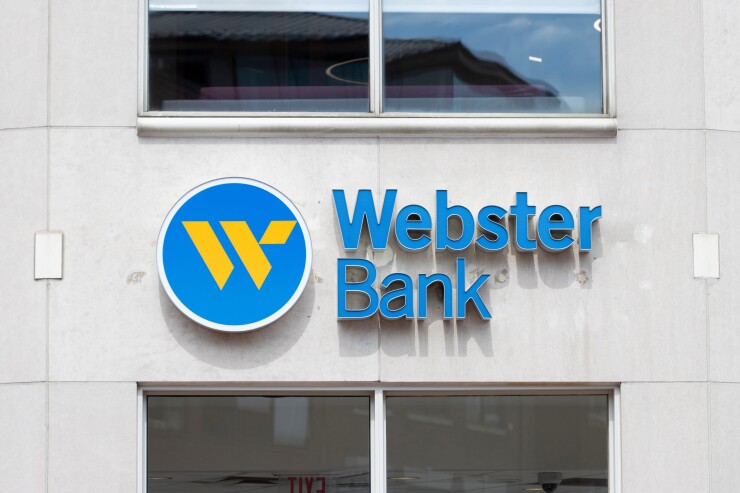
Webster Financial in Stamford, Connecticut, reported the results of a challenging second quarter, falling short of expectations on net interest income and negatively revising much of its 2024 guidance.
The Northeast regional bank also recorded lower-than-expected fee income, another
Webster now predicts that its full-year net interest income will be in the range of $2.32 billion to $2.34 billion, down from the $2.4 billion it forecast in April and the $2.4 billion to $2.45 billion it laid out in January. For the quarter, net interest income totaled $572.3 million, down about 2% from the year-ago period.
While Webster's net interest income has been "relatively solid" compared with broader industry trends, "it has obviously not been as robust as we anticipated earlier in the year," President and CEO John Ciulla told analysts Tuesday.
"We missed the mark on the guidance, obviously, and we're not pleased with it," he said during the $76.8 billion-asset company's quarterly earnings call.
One key factor: Webster's sponsor finance activity isn't growing as expected. Ciulla explained that the sluggishness is due to slower private equity activity, increased competition from private credit markets and lower volumes of loan repricings and refinancings amid the higher-for-longer interest rate environment.
All of those factors "have had the collective impact of muting loan yields," he said. Loans and leases totaled $51.6 million for the quarter, roughly flat versus the same quarter last year.
"We've had a lot of churn in the [sponsor-finance] portfolio," added Ciulla, who said there were "decent originations," but that losing out on hundreds of millions of dollars of anticipated sponsor loans as well as lower overall loan growth "obviously hurt yields."
Investors weren't thrilled with Webster's results. The bank's stock price declined 5.7% Tuesday.
Webster began the year with
Executives slightly changed their tune in April, revising the company's loan growth outlook to around 5% for the year. They acknowledged that ongoing pressure to pay higher rates on deposits could have an impact on lending.
But now the company,
There could be an uptick in the sponsor finance business in the back half of the year, "but we're not relying on a springback," Ciulla said. "We have a higher pipeline, and we are seeing significantly more activity there, but we don't know what will happen with respect to churn in the portfolio."
For the second quarter, Webster reported net income of $177.5 million, down 23% year over year.
Earnings per share totaled $1.03, missing the average estimate of $1.34 from analysts surveyed by FactSet Research Systems.
Similar to its diminished loan-growth expectations, Webster also narrowed its outlook for full-year deposit growth. It's now calling for deposits to increase by about 5% versus the 5% to 7% growth it had predicted in January.
Two Northeast banks will get new CFOs next month. Webster Financial hired Neal Holland, the former CFO of the failed First Republic Bank, and Eastern Bankshares hired David Rosato, who left Berkshire Hills Bancorp last month.
Webster also made a downward revision to its fee income guidance. That forecast, which previously called for fee income of between $375 million and $400 million, now sits at the bottom end of that range.
Second-quarter fee income was $42.3 million, a sharp decline from $89.4 million in the same quarter last year. The decrease was tied to a $49.9 million net loss on the sale of investment securities, the company said.
Meanwhile, Webster's provision for credit losses was $59 million, up from the $31.5 million it set aside in the year-ago quarter. And net charge-offs totaled $33.1 million, up from $20.3 million in the second quarter of 2023. Nonperforming loans and leases came in at $368.8 million, up 68.5% year over year.
The increase in troubled loans was tied to four office loans, executives said. Webster's office portfolio totals about $952 million, of which about 21.5% is currently classified, the company disclosed.
"There [was] no geographic connectivity," Ciulla said about the four problem loans. "It's the overall pressure on office and rents, occupancy and value."
Webster's expenses were $326 million for the quarter, down more than $18 million year over year. The company's full-year expense guidance, which is in the range of $1.3 billion to $1.325 billion, remains unchanged.





